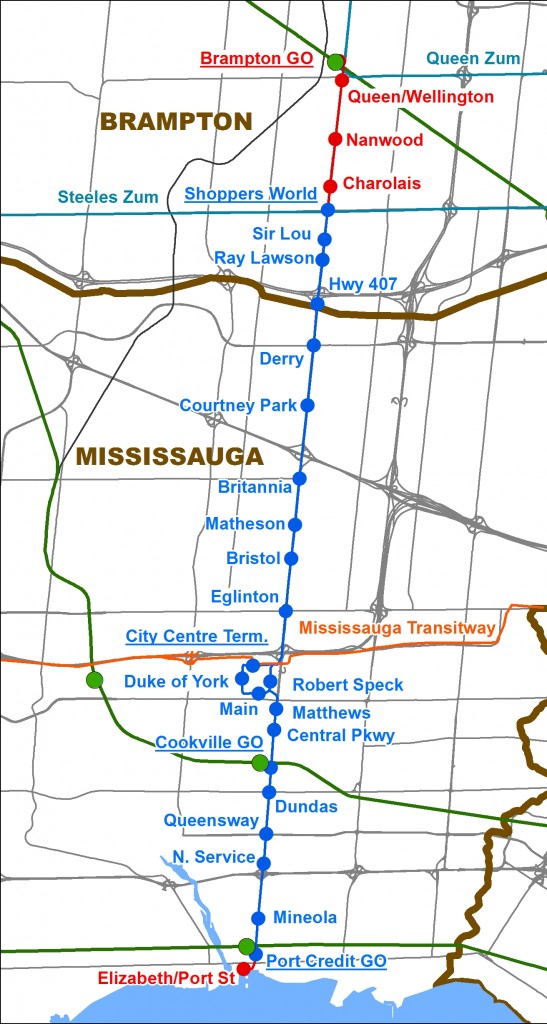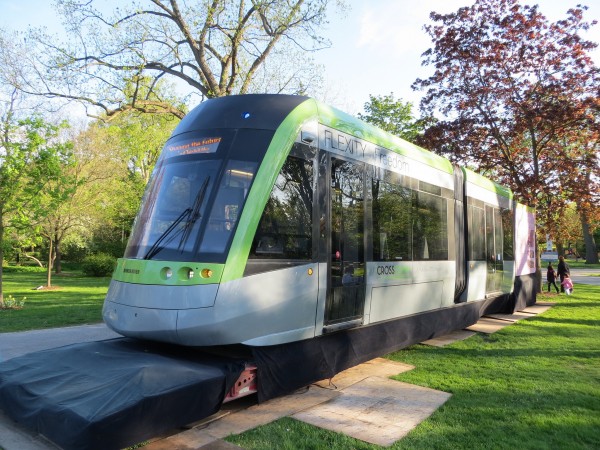Cross-posted from Marshall’s Musings, the author’s personal blog
On late Tuesday night (actually, early Wednesday morning) Brampton City Council made disappointing and harmful decision by voting against the Hurontario-Main LRT, a 23.2 kilometre, $1.6-billion light rail line, whose construction costs would be fully covered by the province. This followed another marathon meeting back in July in which a final decision was delayed to allow for further study and a possible compromise.
The mayor, Linda Jeffrey, and four councillors (Gurpreet Dhillon, Pat Fortini, Marco Medeiros, and Gael Miles) supported the project, but six councillors (Jeff Bowman, Grant Gibson, Elaine Moore, Michael Palleschi, John Sproveiri, and Doug Whillians) voted against. The final vote was 7-4 against the LRT, with Jeffrey mistakenly voting with the majority, but the 6-5 vote against a modified downtown routing in an last-minute attempt to sway opponents should be considered the true decision.
Light rail transit will still be coming to Brampton – construction will start in 2018 – but it will terminate at Shoppers World at Steeles Avenue, with only three stops completely within Brampton’s borders. Nearly four kilometres and four stops have now disappeared, including the crucial terminal at Brampton GO Station. The map below shows the Hurontario-Main LRT route, with the eliminated sections in red. (A short section of the LRT’s route in Port Credit was eliminated due to community opposition; it would have brought light rail transit closer to Port Credit’s bustling core. The Hurontario LRT will now terminate adjacent to the Port Credit GO Station, north of Lakeshore Road.)
The Hurontario-Main corridor was selected for LRT simply because it is one of the busiest transit corridors in the Greater Toronto Area outside the City of Toronto; it connects three GO lines and several major bus corridors, it would help urbanize south Brampton and several neighbourhoods in Mississauga. It’s part of a larger regional network, yet six city councillors in Brampton, looking out for narrow, local interests, sunk it.
Now transit advocates elsewhere are looking to capitalize on Brampton’s loss: at least $200 million of the province’s money won’t be spend. For example, advocates in Hamilton are looking for an opportunity to expand their funded LRT network with Brampton’s cash.

The Hurontario-Main LRT, after Tuesday’s vote.
Arguments against the LRT included heritage concerns (as if trams aren’t found in the centres of historic cities such as Vienna, Istanbul, Brussels, and Amsterdam), claims of low ridership (which were written about by the Toronto Star’s San Grewal), concerns about operating expenses. Some councillors suggested that Queen Street should get LRT first. Others took exception to the fact that most of the route (17.6 kilometres, 19 stops) would be in Mississauga, while only a quarter of the line would operate within Brampton (5.6 kilometres and eight stops) But one cannot dismiss the NIMBY factor – some of the biggest opponents were wealthy homeowners on Main Street. Even former Premier Bill Davis, long regarded as a friend of cities and public transit, came out publicly against the LRT. Davis will long be remembered for stopping destructive expressways, but won’t support public transit when it runs down his street.
Opponents suggested other routes, or tunneling under Main Street. But those alternatives were more expensive, more difficult, less convenient for riders, and weren’t going to be funded by the province. These suggestions were studied by city staff and outside consultants and rejected.
Yes, Queen Street is Brampton Transit’s busiest corridor. Yes, the ridership will be lower north of Steeles Avenue than through central Mississauga. Yes, there will be some traffic impacts on Main Street.
But there’s no current planning study for a potential Queen Street LRT; a route hasn’t been chosen (would it go to the Spadina Subway extension to Vaughan? York Region would have to be on board), there’s no funding on the table, and the Hurontario corridor in Mississauga is a lot busier than Highway 7 in York Region. And yes, Mississauga benefits more from the LRT. But Mississauga has a larger population, a much larger transit ridership, and more jobs. By connecting to Downtown Brampton, the LRT increases mobility for the entire region, connects to the Kitchener GO line, and allows for direct transfers to the 501 Queen Zum, Brampton’s busiest bus route. It is part of a regional transit network; it would have made it a lot easier for trips, for example, between Downtown Guelph and Mississauga City Centre.
Just adding to my frustration, Councillor Bowman, who helped sink the Main Street section of the LRT, is now going to look for transit funding from the newly elected Liberal federal government. In the article, Bowman suggests that since Brampton elected five new Liberal MPs, helping to defeat the Conservatives, it was time to “leverage” that support. Payback, if you will. But there are no other plans to hold up, nothing that’s “shovel-ready.” There will be no ribbon-cuttings for Liberal MPs and cabinet ministers to attend anytime soon.
If looking for money from a new federal government – one that’s so far very friendly with their provincial counterpart – it would have looked a lot better to have approved the transit that the province, and a majority of Bramptonians, wanted, and then ask for additional funds to build on that. Advocating for a potential Queen Street LRT would be a lot when there’s an existing line to connect it, and a strong transit-focused hub to anchor it.
So, to sum up, Brampton city councillors threw away at least $200 million for a light rail project that they didn’t want, a gift-wrapped transit opportunity from the provincial Liberal government. Now they will be looking for new transit funding for alternative transit routes, which have yet to be planned, from the federal Liberal government. Good luck with that.





7 comments
Metrolinx should make the correct decision and go ahead with the LRT through Brampton, as presented.
I’m with W.K. Lis on this. Can’t the province override the city? It’s a reigonal route that benefits everone.
As a former Bramptonian and someone who still works and spends a lot of time in the west-end of the GTA, I can say that the true benefits of a north-south LRT are immesureable. All the regional transit in the area is Toronto-centric currently with the sole exception of the BRT between Mississauga and Brampton.
This is why Metrolinx needs to go beyond being just a planning body. The Province needs to create a more effective regional planning body / transit authority. Kind of what the TTC became with amalgamation / or the MTA. I understand that there’s a shit ton of political resistance to this, but it’s only way forward, eventually road blocks like these will continue and the region will be a mess.
With fare integration, Metrolinx will start collecting fares for the entire region, wonder what if that will change anything for them..
This is the legacy of Rob Ford and a provincial government that did not show backbone when the “regional transit plan“ was put to the test.
By allowing Ford to cancel Transit City and other elements already a go, Metrolinx and its political masters indicated that any municipal council that did not want transit, in the form they desired, could simply back out. An alternative of nothing is what many rather have, and it is what they will get – on Sheppard Ave East, and i would guess on Main St Brampton as well.
What we don`t need is a regional transit agency that can do what it wants at the province`s whim. Instead we need a regional transit agency that has elected municipal representatives on its board. It won`t solve everything, but it will get us to a better place where their legitimacy comes from the leaders that make the transit decisions anyways.
Not *too* surprising that Bill Davis would come out against the Main Street LRT… it would run right by his front yard. And of course, many other fine, heritage (and not so heritage) homes of suburban squires whose feathers would be ruffled by such urbanism.
I think this article misses one additional point from the no side – some councillors saw this “stub” of the “Mississauga LRT” as not a fair share for Brampton. I’m not sure I agree with this, but this has been mentioned. And this is why Councillor Bowman is seeking another project to get Brampton’s “fair share”. This decision is a classic example of Old Brampton trying to hold back New Brampton.
Second, while everyone would enjoy Metrolinx jumping in, reality would suggest no. Metrolinx still has to work with its regional municipalities and acquiesces to their duly-elected councils for guidance – and for very good reason. Provincial seats are always up for grabs and the province doesn’t want to give ammunition to the opposition and make Brampton competitive. Additionally, if Metrolinx decided this was the hill to die on and built the LRT as planned, the next project that comes down the pipe would be even more difficult to build, with more hardened resistance from municipalities and then Metrolinx becomes persona non grata.
“with Jeffrey mistakenly voting with the majority..” — What an idiot! ???
“Nearly four kilometres and four stops have now disappeared, including the crucial terminal at Brampton GO Station.” — What a missed opportunity ! ???